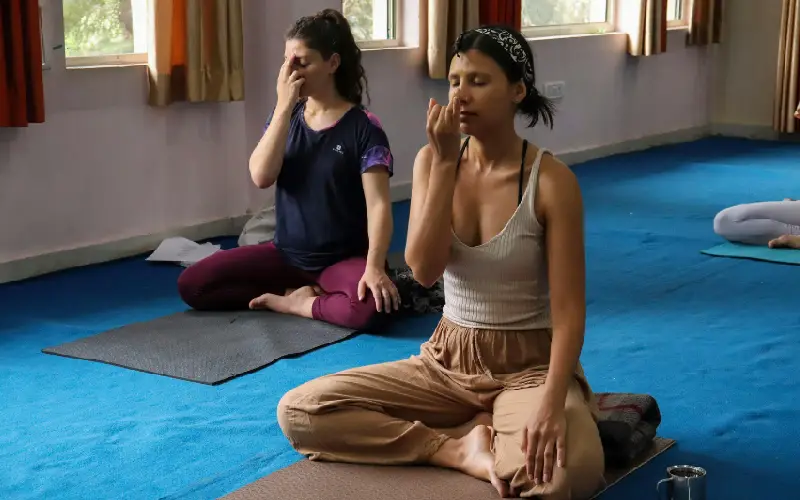Introduction
Pranayama is an essential component of yoga that involves the regulation and control of the breath. The term “pranayama” is derived from two Sanskrit words: “prana” meaning life force or vital energy, and “ayama” meaning extension or control. Thus, pranayama translates to the control or extension of the life force. This practice is considered crucial for achieving physical, mental, and spiritual well-being. Yogic pranayam techniques can enhance lung capacity, reduce stress, and promote overall health.
The Importance of Pranayam in Yoga
In yoga, breath is considered the bridge between the body and the mind. Proper pranayam techniques can help regulate the nervous system, enhance concentration, and facilitate deeper meditation. Breath control is fundamental to many yoga practices, serving as the foundation for physical postures (asanas) and meditation.
Types of Yogic Pranayam Techniques
1. Ujjayi (Victorious Breath)
Technique:
- Sit comfortably with your spine straight.
- Inhale deeply through your nose, slightly constricting the back of your throat to create a soft, oceanic sound.
- Exhale through your nose with the same throat constriction, maintaining the sound.
Benefits:
- Calms the mind and reduces stress.
- Enhances concentration and focus.
- Increases oxygen intake and lung capacity.
2. Nadi Shodhana (Alternate Nostril Breathing)
Technique:
- Sit comfortably with your spine straight.
- Use your right thumb to close your right nostril.
- Inhale deeply through your left nostril.
- Close your left nostril with your right ring finger, and exhale through your right nostril.
- Inhale through your right nostril, then close it and exhale through your left nostril.
Benefits:
- Balances the left and right hemispheres of the brain.
- Promotes mental clarity and emotional stability.
- Reduces stress and anxiety.
3. Kapalabhati (Skull Shining Breath)
Technique:
- Sit comfortably with your spine straight.
- Take a deep inhale through your nose.
- Forcefully exhale through your nose, contracting your abdominal muscles.
- Allow passive inhalation and repeat the exhalation in quick, rhythmic bursts.
Benefits:
- Cleanses the respiratory system and clears the nasal passages.
- Energizes the body and mind.
- Improves digestion and metabolism.
4. Bhramari (Bee Breath)
Technique:
- Sit comfortably with your spine straight.
- Close your eyes and cover your ears with your hands.
- Take a deep inhale through your nose.
- As you exhale, make a humming sound like a bee, feeling the vibration in your head.
Benefits:
- Calms the mind and reduces stress.
- Relieves tension and anxiety.
- Promotes restful sleep.
5. Sheetali (Cooling Breath)
Technique:
- Sit comfortably with your spine straight.
- Roll your tongue into a tube and stick it out slightly.
- Inhale through the rolled tongue, feeling the cool air.
- Close your mouth and exhale through your nose.
Benefits:
- Cools the body and reduces heat.
- Alleviates stress and anxiety.
- Balances pitta dosha (according to Ayurvedic principles).
6. Dirga (Three-Part Breath)
Technique:
- Sit or lie down comfortably.
- Place one hand on your belly and the other on your chest.
- Inhale deeply into your belly, then your ribs, and finally your chest.
- Exhale fully, releasing the air from your chest, ribs, and belly in reverse order.
Benefits:
- Promotes full and complete breathing.
- Reduces stress and anxiety.
- Increases oxygen intake and lung capacity.
Benefits of Yogic Pranayam
Physical Benefits
- Enhanced Lung Capacity: Increases lung capacity and improves respiratory efficiency.
- Improved Cardiovascular Health: Lowers blood pressure, reduces heart rate, and enhances cardiovascular function.
- Boosted Immune System: Oxygenates the blood, supporting immune function and detoxification.
- Better Digestion: Stimulates the digestive organs and improves metabolism.
Mental and Emotional Benefits
- Reduced Stress and Anxiety: Activates the parasympathetic nervous system, promoting relaxation.
- Enhanced Mental Clarity: Improves cognitive function and concentration.
- Emotional Stability: Balances emotions and promotes a sense of calm.
Spiritual Benefits
- Deepened Meditation: Helps quiet the mind and deepen the meditative state.
- Increased Self-Awareness: Fosters a greater connection to oneself.
- Spiritual Growth: Leads to heightened awareness and connection with universal life force.
Incorporating Yogic Pranayam into Daily Life
- Start Slowly: Begin with a few minutes each day and gradually increase.
- Create a Routine: Practice at the same time daily, ideally morning or before bed.
- Practice Mindfulness: Use breath awareness during stressful moments.
- Combine with Asanas: Coordinate breath with yoga postures.
- Seek Guidance: Learn techniques from a qualified instructor.
Conclusion
Yogic pranayama is a powerful practice that offers numerous physical, mental, and spiritual benefits. By learning and incorporating pranayam techniques into your daily life, you can enhance your overall health and well-being. Whether your goal is to reduce stress, improve respiratory function, or deepen meditation, pranayama provides a valuable tool for balance and harmony. Consistency and mindfulness are key to unlocking the full potential of yogic pranayam.
Comments ( 1 )
Comments are closed.



Tortor condimentum lacinia quis vel eros donec. In cursus turpis massa tincidunt. Blandit aliquam etiam erat velit scelerisque in. Consequat interdum varius sit amet mattis. Fusce id velit ut tortor. Nunc faucibus a pellentesque sit.